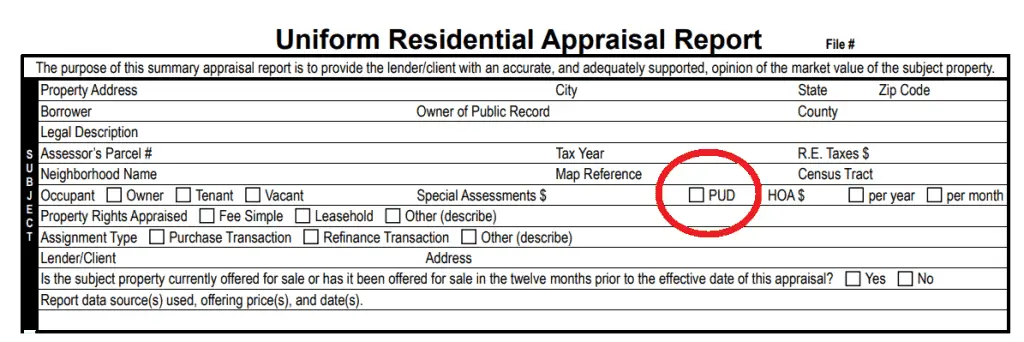(**) Disclosure: This post may contain affiliate links, meaning RealEstateCareerHQ.com will get a commission if you decide to make a purchase through the links, but at no additional cost to you.
It’s a beautiful morning, and I was thinking of the next topic for this appraiser website. As I was researching, I came across the term, PUD numerous time. So I dug further about it, and believe this could be helpful knowledge to your appraisal work. So I thought it would be interesting to share what I found with you.
What is a PUD? PUD stands for Planned Unit Development. It’s a community of homes where homeowners would pay a monthly HOA fee for services in the common area such as parks, pools, security, road cleaning.
In this post, I’ll go over the definition of PUD, its pros and cons, and what appraisal form to use when you’re working on such assignment.
What Defines a PUD?

The general concept of a Planned Unit Development (PUD) is not too difficult to understand. It is when homes are regulated by a Homeowner Association (HOA), and property owners will pay a monthly fee. In return, HOA will arrange for services to maintain the amenities in the common area. These amenities are exclusively for the residents in the community.
Depending on the agreement set up in the HOA documents, below is a list of services that I often see.
- maintaining amenities such as swimming pool, tennis court, gym facilities, playground, parks
- security monitoring
- landscaping
- lawn mowing
- snow shoveling
The members of HOA are responsible for the administrative duties and attend meetings with other board members. The actual services are usually outsourced to a third-party property management company.
Different Interpretations of the PUD definition

From the above standpoints, it seems that many townhouses, condos, or even commercial units could be considered as PUD. However, due to the variation of PUD definitions wording across different entities, there is confusion on what constitutes a property to be a PUD.
For example, according to the Fannie Mae Selling Guide:
A PUD is a project or subdivision that consists of common property and improvements that are owned and maintained by an HOA for the benefit and use of the individual PUD units. For a project to qualify as a PUD for the purposes of this policy, all of the following requirements must be met:
– each unit owner’s membership in the HOA must be automatic and nonseverable,
– the payment of assessments related to the unit must be mandatory,
– common property and improvements must be owned and maintained by an HOA for the benefit and use of the unit owners, and
– the subject unit must not be part of a condo or co-op project.
Quote from Fannie Mae Selling Guide B4-2.3-01: Eligibility Requirements for Units in PUD Projects (06/05/2018)
On the other hand, from the Dictionary of Real Estate Appraisal, it defines PUD as the following:
a type of residential, commercial, and/or industrial land development in which buildings are clustered or set on lots that are smaller than usual, and large, open, park-like areas are included within the development.
Quote from Dictionary of Real Estate Appraisal
This definition is more restrictive as it requires the properties to cluster in smaller lots. However, the Fannie Mae guide especially states that Zoning is not a basis to classify whether a property is PUD.
I looked at a few more examples. Let’s take a look at the PUD definition from the Department of Housing and Urban Development.
A PUD is defined as a mixed-use residential development of single-family dwellings in conjunction with rental, condominium, cooperative or town house properties. A residential development should be processed as a PUD if it has these minimum characteristics:
o a homeowner association that holds either title in fee or a lease of prescribed length on the common area
o mandatory membership of all unit owners (or units) in the association
o the right of all unit owners to participate by vote in the operation of the association
o lien supported assessment of the members to meet the association’s budgeted operating costs (special assessments may be handled differently
In the HUD definition, it says all PUD unit owners have the right to participate by a vote in the operation of the association. However, Fannie Mae allows PUD projects where the developer has not turned over voting control of the HOA to unit owners. This is called the “Type F” PUD project.
Is a condo a PUD?
It is a common argument between appraisers. Some believe condo should not be classified as a PUD because the unitholders do not own the land. But some appraisers do not agree. They suggest as long as there is a mandatory HOA membership requirement (One that cannot be opt-out) where homeowners need to pay a regular fee, then it fulfills the PUD definition.
What should you do as an appraiser about PUD assignment?

Some appraisers said the AMC returned their appraisal because they did not check the PUD box. Even though there are HOA fees involved, they do not believe that automatically classify the unit to be PUD.
[Read: What is an Appraisal Management Company (AMC)?]
Since the assignment is for a lender, the best would be to consult their review appraiser and understand how they classify a PUD. As always, make sure your work complies with the State regulation.
Pros of Owning PUD Units
There are several major benefits of owning a PUD unit. The property management company will take care of the maintain the common area, so residents don’t have to go through the hassle in handling it themselves. This is especially appealing to busy property owners and those who are not very handy.
It maintains the quality of the neighborhood to a predefined standard. Therefore, the property price would be less impacted by poor neighborhood appearance.
Due to the scale of the economy, the costs to maintain the neighborhood could be lower than individual resident hiring than own contractor
Cons of Having a PUD Unit
1) No one likes to pay fees

The obvious disadvantage is homeowners would need to pay for the HOA fees. This could be a monthly or quarterly charge. If you hire a poor property management company, they could end up wasting lots of your reserve, which ultimately would lead to an increase in the HOA fees.
Having a high HOA fee could deter potential homebuyers, which negatively affect the prices of all units. It also affects the eligibility in getting a mortgage for this property, since high HOA fees could increase debt-to-service ratios.
2) All residents co-pay for other’s mistake
Furthermore, the common area is shared between residents. There is a free rider problem such that some irresponsible residents could abuse using the facilities. For example, I have seen parents allowing their kids to leave garbage on the playground, adults not turning off the water valve after usage.
I’m sure they would not do that if they own 100% of these amenities. But the reality is they only need to contribute a small portion of all the costs.
3) Less flexibility in managing your property
For a non-PUD unit, the homeowner can renovate the exterior of their property as long as the laws permit it. In some instance, they could even take down the entire unit and rebuild it. They just need to get approval from the local government.
However, since HOA rules are regulating the PUD units, there could be a specific guideline on what can or cannot be done. For example, they might not allow you to change the color of your roof shingles or garage door. This is to make the neighborhood appearance more uniform.
What Appraisal Form is Used for a PUD?
For appraisal where only the exterior property inspection is performed, you can use the Form 2055. I’ll include a link in the reference session of the post. According to the Fannie Mae Guideline, if the appraisal consists of both interior and exterior inspection of the property, then you may use the Form 1004. It is a seven pages Uniform Residential Appraisal Report, and there’s a section where you could check off for PUD unit.

For appraisal where only the exterior property inspection is performed, you can use the Form 2055. I’ll include a link in the reference session of the post.
Conclusion
The structure of a PUD indeed has many benefits which help homeowners in maintaining the amenities in the common area. When the neighborhood is in good condition, it could translate into higher home prices.
However, poor property management could lead to totally the opposite, while resulting in skyrocketing HOA fees. When you are creating an appraisal, it is crucial to go over the HOA documents. Understand the trend of the HOA fees, the outstanding repairs need to be done, and the money reserve available.
Want to enhance your appraisal knowledge? Check out our education resource page.
Disclaimer: The information in this post is for general information only, and not intend to provide any advice. They are subjected to change anytime without notice, and not guaranteed to be error-free. For full and exact details, please contact the Appraisal Board in your state, the education or service provider.
Reference:

